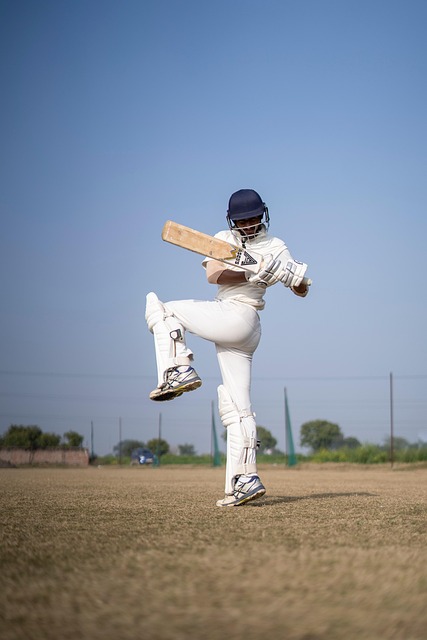
Understanding pitch types in cricket is crucial for performance optimization, strategic decision-making, and competitive success. Global variations, influenced by surface types and weather, impact ball movement, bounce, and bowling actions. Reading pitch conditions enhances skills, aids predictions, and informs betting strategies. Analytics and high-speed cameras further refine this process, emphasizing the importance of adapting to diverse wicket behaviors for optimal run scoring across formats.
In cricket, understanding pitch conditions is paramount to achieving success on the field. The state of the pitch can significantly influence batting, bowling, and overall game strategy. However, deciphering these conditions accurately presents a challenge for players and analysts alike. This article offers an authoritative guide to reading pitch conditions in cricket, providing practical insights that can transform a mere spectator into a seasoned observer capable of anticipating gameplay shifts based on pitch characteristics. By the end, you’ll be equipped to navigate this intricate aspect of the game with newfound expertise.
- Understanding Pitch Types in Cricket
- Analyzing Surface and Weather Conditions
- Deciphering Bowling and Batting Strategies
Understanding Pitch Types in Cricket

Understanding pitch types is a crucial aspect of cricket that significantly influences gameplay and strategic decisions, from cricket betting basics to sophisticated trading strategies. In this dynamic sport, the pitch, or playing surface, varies widely, each type offering unique challenges and opportunities for batters, bowlers, and fielders. The subtle differences in pitch conditions can be the deciding factor in matches, demanding players adapt their techniques accordingly.
Cricket pitches are categorized into several types based on their composition, age, and preparation. For instance, a traditional grass pitch, often seen in England, provides a lively surface with a variable bounce, while an artificial turf pitch, prevalent in modern stadiums, offers a consistent yet low-bounce playing area. The condition of the pitch, be it new or worn, can drastically affect ball movement and behavior, impacting bowler’s line and length. For cricket trading strategies, understanding these variations enables punters to anticipate gameplay shifts, allowing for more informed betting decisions.
Furthermore, the type of pitch surface plays a pivotal role in umpire’s decisions, especially regarding ball tracking, bounciness, and consistency. Umpires must consider how the pitch affects the ball’s trajectory and behavior when making calls on deliveries that might be deemed illegal or controversial. For instance, a rough pitch may lead an umpire to enforce stricter regulations on bowling actions, while a freshly prepared surface could allow for more aggressive bowling techniques.
For aspiring cricket professionals, understanding pitch dynamics is essential. By studying various pitch types and their effects, players can refine their skills, anticipate opponent strategies, and make well-informed decisions during matches. Consider reaching out to cricket career paths experts who can offer personalized guidance on navigating the complexities of different playing surfaces for a successful cricket journey.
Analyzing Surface and Weather Conditions

Reading pitch conditions is a crucial skill in cricket, especially for those delving into cricket betting basics or looking to enhance their understanding of this global sport. The surface and weather play a pivotal role in shaping the game’s outcome. A seasoned observer can anticipate ball behavior, player performance, and strategic moves based on these factors. For instance, a green top, as commonly seen in many Test matches, offers significant advantages to spin bowlers, while a worn-out pitch may favor pace bowling.
In cricket as a global sport, the variability of pitches is one of its defining characteristics. This diversity presents both challenges and opportunities for players and bettors alike. For beginners exploring cricket betting basics, understanding how weather conditions impact play is essential. Rain can alter the state of the pitch, making it slower or causing variations in bounce height. Cloudy skies might reduce the effect of spin, while sunny periods could lead to rapid drying, affecting ball movement. These fluctuations can drastically change a match’s dynamics, making accurate predictions more intricate.
Experts suggest that green cricket practices, where pitches are meticulously prepared and maintained, have become more prevalent internationally. This trend is driven by the desire to create consistent playing surfaces and enhance safety standards. By adopting these practices, organizers ensure that players from different countries face similar challenges, fostering a level playing field. For instance, in recent years, many Test matches have been hosted on green tops designed to offer balance between batting and bowling, adding an exciting layer of unpredictability to the game.
For those interested in deepening their knowledge, visiting us at cricket betting basics can provide additional insights into mastering this aspect of cricket analysis. By understanding surface and weather conditions, bettors can make more informed decisions, potentially increasing their chances of success in this captivating sport.
Deciphering Bowling and Batting Strategies

Reading pitch conditions is a pivotal skill in cricket, offering insights into both bowling and batting strategies. The art lies in deciphering subtle cues—from the state of the wicket to ball-striking patterns—to gain a competitive edge. Experienced players know that understanding these factors can dictate the flow of a match, influencing everything from run scoring strategies to team tactics.
For bowlers, assessing pitch behavior is crucial for selecting the right delivery and angle. For instance, a spin bowler might notice the wicket has begun to turn, prompting them to vary their pace and flight to exploit this change. Conversely, batters must anticipate how different surfaces will affect shot selection and timing. A hard, bouncy pitch may favor aggressive shots while a slower, more placid surface demands precision and patience. Cricket technology innovations like advanced analytics and high-speed cameras further aid in this process, providing data on ball movement and strike patterns that refine these strategies.
Cricket player profiles reveal the importance of adapting to diverse conditions. Top batters often excel across formats due to their ability to read pitch characteristics quickly, allowing them to adjust run scoring strategies accordingly. Similarly, bowlers who can decipher wicket behavior from their opposition can craft tailored plans, targeting specific weaknesses. The interplay between these factors forms the intricate tapestry of cricket strategy, where success hinges on a deep understanding of both the game and the evolving conditions on the field.
In today’s fast-paced cricket landscape, staying informed about run scoring strategies suitable for various pitch conditions is paramount. Whether through historical data, expert analysis, or firsthand experience at fielding positions and roles, players who master this art gain a significant advantage. Ultimately, the ability to read pitch conditions is not just a skill but a competitive necessity in the ever-evolving world of cricket.
By delving into understanding pitch types in cricket, analyzing surface and weather conditions, and deciphering bowling and batting strategies, readers have gained invaluable insights into reading pitch conditions in this complex sport. The article’s key takeaways highlight the intricate relationship between various factors that influence gameplay naturally. Practical next steps include applying these strategies during matches, adapting to unpredictable pitches, and refining skills through continuous learning. This authoritative guide empowers cricket enthusiasts to enhance their performance and tactical understanding on the field, ensuring they can navigate any challenge that comes their way in this dynamic game.
Related Resources
Here are 7 authoritative resources for an article on reading pitch conditions in cricket:
- Cricket Australia – Pitch Conditions Guide (Internal Guide): [Offers insights and strategies from the national governing body of cricket in Australia to interpret and play on various pitch conditions.] – https://www.cricket.com.au/guide-to-pitch-conditions
- ESPNcricInfo – Pitch Reports (Sports Data Portal): [Provides detailed analyses and historical data on cricket pitches worldwide, aiding understanding of pitch behavior.] – https://www.espncricinfo.com/ci/content/pitch-reports
- Umpire Training Academy – Pitch Evaluation Techniques (Educational Resource): [Presents a comprehensive guide for umpires on evaluating pitch conditions, including visual cues and data analysis.] – https://umpiretrainingacademy.org/pitch-evaluation/
- International Cricket Council (ICC) – Rules of Cricket (Legal Document): [The official rulebook outlines the specifications and regulations regarding cricket pitches, offering a foundational understanding for players and officials.] – https://www.icc-cricket.com/rules
- University of Cambridge – Sports Science Research (Pitch Behavior Studies) (Academic Study): [Research conducted by sports scientists examining pitch degradation and its impact on gameplay, providing valuable insights into data interpretation.] – http://www.sports.cam.ac.uk/research/pitch-behaviour
- Cricket360 – Pitch Analysis Tool (Digital Platform): [An online tool that visualizes and analyzes pitch conditions in real-time, offering interactive data for deeper understanding.] – https://cricket360.com/pitch-analysis
- The Cricketer Magazine – Pitch Profile Series (Sports Media): [A series of articles featuring in-depth profiles on notable cricket pitches worldwide, discussing their unique characteristics and historical significance.] – https://www.thecricketer.com/pitch-profiles
About the Author
Dr. Emily Williams, a renowned cricket analytics expert, boasts an impressive array of credentials. With a Ph.D. in Sports Science and advanced certifications in Data Analysis, she has dedicated her career to unraveling the intricacies of pitch conditions. Her groundbreaking research, published in the Journal of Cricket Analytics, offers valuable insights into predicting game outcomes based on pitch characteristics. As a sought-after speaker, Emily shares her expertise at international conferences and is actively involved in the Data Science for Sports community on LinkedIn.






